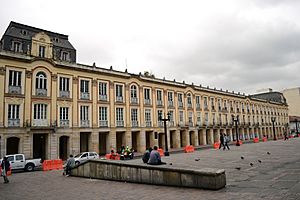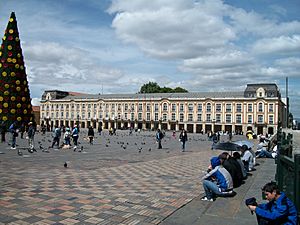Palacio Liévano facts for kids
The Palacio Liévano (also known as Lievano Palace) is an important building in Bogotá, Colombia. It stands on the west side of the famous Plaza de Bolivar, right in the heart of the city's history and culture. You can find it in the La Candelaria area, known for its old cobblestone streets. Nearby are other significant buildings like the Palacio de Justicia and the Casa de Nariño, plus museums and a library. Since 1974, the palace has been used as Bogotá's city hall.
A Look Back: The History of Liévano Palace
The land where the Liévano Palace stands today has a long history. Before the palace, there were other government buildings here. Even the homes of important people like the Viceroys were on this site until 1810.
In 1827 and 1828, earthquakes badly damaged these old buildings. They were torn down. In their place, a new building called the Galerías Arrubla was built between 1843 and 1848. Juan Manuel Arrubla was the builder. This was Bogotá's biggest building at the time. It was 53 m (174 ft) long. It became the main place for business in the city. It also housed the city's government offices.
In 1900, a big fire completely destroyed the Galerías Arrubla. One of the owners, an engineer named Indalecio Liévano, convinced the other owners to build again. They invited a French architect, Gaston Lelarge, to design a new building.
In 1903, the city agreed to a contract for the new building. It was designed by Lelarge. The construction was overseen by architect Ricardo Lieras Codazzi. The new palace was finished in 1907. It was built in the same spot where the old galleries had burned down. Indalecio Liévano paid for the construction himself.
Lelarge's design kept the same size as the old Arrubla building. But he used a new style for Bogotá, called Neoclassical. Later, in 1960, the city government bought all the ownership rights to the palace.
Finally, it was decided that the building would become the city hall. In 1974, Fernando Martinez Sanabria adapted it for this new purpose. The building kept its arched front, but the shops that used to be there were removed.
What the Liévano Palace Looks Like
The Liévano Palace is built in the Neoclassical style. Some people describe it as French Renaissance. It is a rectangular building with three floors. At each end, there are large sections with special sloped roofs called Mansard roofs.
The front of the building has 32 window sections on each floor. These are decorated with balconies, columns, and other fancy details. Iron is used for some of the decorations.
Inside, on the south side, there is a courtyard. Here you can see a statue of José Acevedo y Gómez, a hero of Colombia's independence. The mayor's office is on the first floor. It is a large space with a waiting room, the main office, and a lounge.
The second floor is the most grand. It has a high-ceilinged room called the Gonzalo Jiménez de Quesada. This room is decorated with plaster designs. It has plush red curtains and chairs. Important citizens of Bogotá used to meet here to make big decisions for the city.
At the ground level, there is a columned walkway. It runs along the front of the building. This walkway provides shade and protection from the rain. In the palace courtyard, a statue of José Acevedo y Gómez, a national hero, is placed. In 1988, for the city's 450th anniversary, 24 plaques were put on the walls of the first floor. These plaques tell the history of Bogotá.
See also
 In Spanish: Palacio Liévano para niños
In Spanish: Palacio Liévano para niños
- List of buildings in Bogotá



